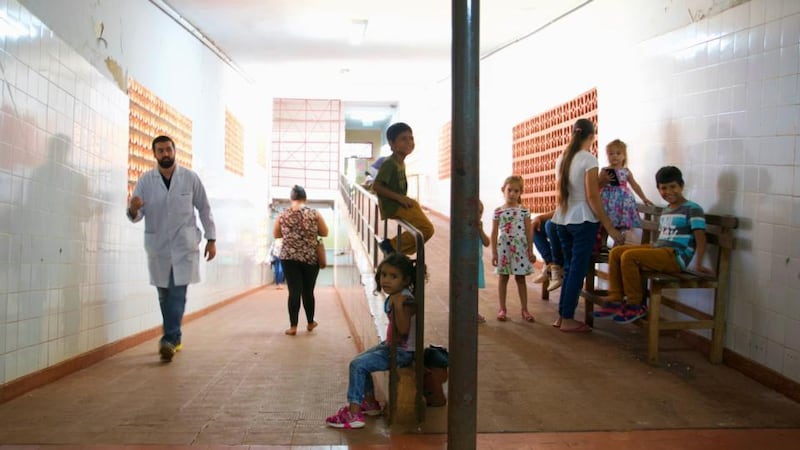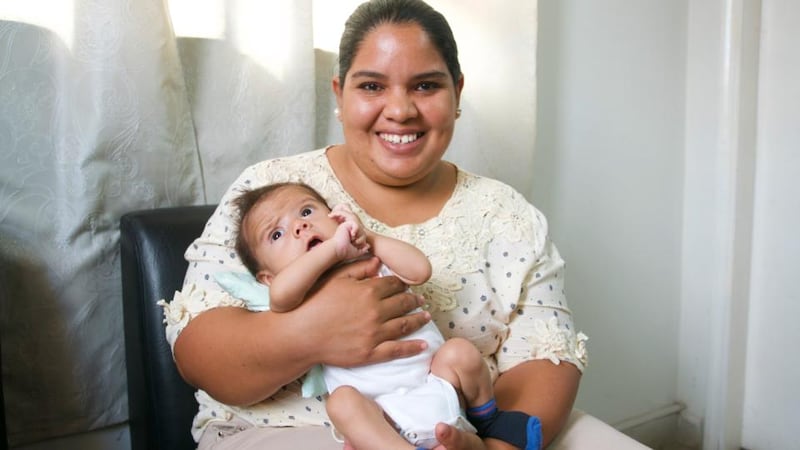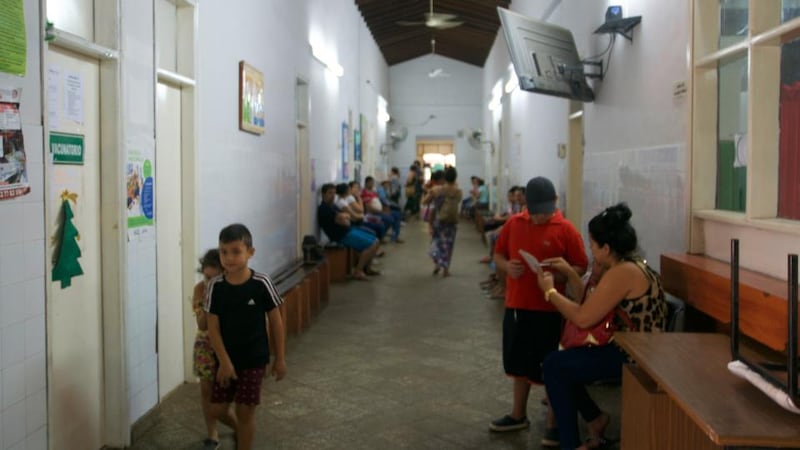Graciela Romero bounces her four-month-old son on her knees as she recounts her aunt’s final moments.
“Aunt Aida Maria had all the symptoms and looked horrible but by the time she made it to this hospital, she’d had several seizures and was convulsing,” explains the 26-year-old mother, tears staining her cheeks.
Loma Pyta Hospital, on the outskirts of Asunción, is a medical hub for Paraguayans living in rural areas. Aida Maria made it there after she had already been sent home three times by another hospital in a 24-hour period despite showing symptoms of pre-eclampsia.
This is a pregnancy complication characterised by high blood pressure and signs of damage to another organ system, most often the liver and kidneys.
Pregnant women can develop the condition from 20 weeks gestation and just after giving birth. While its cause remains unknown, factors such as diabetes and obesity, existing high blood pressure, kidney disease and maternal age increase the risk.

What makes pre-eclampsia so deadly is that it is a silent killer, as its victims feel well in the early stages of the illness, despite suffering internal organ damage.
Heralded by the World Bank for its impressive economic growth, Paraguay's economy has grown faster than most of its neighbours in Latin America since 2004. However, its healthcare system has struggled to reduce the number of pregnant women and infants who die each year.
Pre-eclampsia has been the number one cause of maternal deaths since 2017 and mortalities continue to rise.
"The death of a mother has a huge economic and social impact on the country. We are facing a lot of pressure internationally due to our high number of cases," says Dr Gladys Ester Mora, director of sexual and reproductive health at the country's health ministry.
Emergency Caesarean
When she arrived at the hospital, Aida Maria (37) had a seizure while doctors tried to get her out of her car and into the operating room. She died in the hallway, leaving doctors only three minutes to remove the baby before it would also die. Onlookers watched as the medical team performed a rough emergency Caesarean on Aida Maria’s corpse in the middle of the hospital hallway to try to save her daughter.
“Her six-year-old son talks to the moon and the stars, saying his mum has been taken elsewhere,” says Romero.
Only months after Aida Maria’s death, doctors diagnosed Romero with being at high risk for pre-eclampsia 16 weeks into her pregnancy. She attended every medical appointment and took aspirin and calcium as advised by her doctors. Her son Joel was born at term.

“I was really worried, and I wasn’t sure the baby would be okay, but I trusted in God and knew I was in good hands at this clinic,” she says, clutching her four-month-old son. “I came out of the hospital with my baby, my aunt didn’t.”
Routine prenatal blood and urine checks are the best way to diagnose pre-eclampsia and these, alongside preventative measures such as the provision of aspirin and calcium to high-risk patients, have virtually eliminated the illness in Europe and North America.
However, the US-based Pre-eclampsia Foundation reports that 76,000 women and 500,000 infants globally still die every year from this illness.
According to data from the World Bank, Paraguay has lagged behind most of its South American neighbours in reducing maternal mortality rates over the past decade, only reducing them from 120 to 90 deaths per 100,000 live births in the past decade.
Even Bolivia – the poorest country on the continent and with the highest maternal mortality rate – has reduced its maternal deaths by 50 per cent over the same time period.
Struggle to diagnose
Paraguayan doctors and midwives face an uphill struggle to diagnose pre-eclampsia early enough to save their patients. Due to scant economic resources, poor education and long distances between hospitals, patients often aren’t able to receive medical attention throughout their pregnancy.
A lack of regular supplies of equipment and medicine such as aspirin and calcium, compounded with a high teen pregnancy rate, means that doctors often detect pre-eclampsia only when the mother or child’s life is already at risk. The situation is particularly acute in rural parts of the country, but the problem also exists in Asunción, the capital city.
Pressure on the health system has mounted as coronavirus spreads around the world.
“When a teenager with an unplanned pregnancy and without any knowledge of pregnancy or pre-eclampsia comes to a clinic and all the necessary items to provide high-quality prenatal care may not be available, it makes me think that there is so much more work that needs to be done here,” says Dr Gustavo Brítez Arbués, a gynaecologist from Clinicas Hospital in Asunción.
The health ministry says situations such as this arise due to some medical professionals being unaware of the symptoms or the severity of the illness, leaving patients misdiagnosed and untreated. This problem is particularly acute in rural areas where access to healthcare remains limited.
In an attempt to fix this, the government developed a national mobilisation strategy in 2019 to help curb pre-eclampsia rates. The key part of this plan is to reach all regions of the country with training on the prevention and early detection of pre-eclampsia. However, a lack of funding and supplies compounded with a large geographic area have hindered their progress.

“We have been working on this since 1988. There shouldn’t be any maternal deaths, especially preventable ones like those from pre-eclampsia,” said Mora, of the health ministry.
Along with a lack of awareness, missing data and negligence remain two stumbling blocks to reducing pre-eclampsia deaths, the ministry says. Mora says not only do certain medical practitioners ignore protocol, they chronically under-report cases. There are no consequences for failing to report a death.
Knowledge gap
Government agencies and non-profit organisations have been trying to fill the knowledge gap by raising awareness of the disease to save more women and children. The Juan Rassmuss Echecopar Foundation, a non-profit organisation, is working with the government to educate health professionals on the danger of pre-eclampsia by training healthcare workers and providing medical equipment.
"As a young woman, I feel it is deeply unfair that women and babies in the 21st century are dying of a preventable disease, which wasn't talked about in Paraguay only three years ago," says Katherine Young Barker, the foundation's pre-eclampsia project co-ordinator.
The Paraguay-based NGO says it trained 400 health professionals and reached 15,000 pregnant women through its 2019 campaign in Asunción, resulting in a 47 per cent drop in the number of pre-eclampsia patients within the first year in the first partner hospital. Other partner hospitals across the capital report similar promising results.
Outside Asunción, the situation is dire. Cyndi Gimenez sits in a hospital bed in Ciudad del Este, recovering from pre-eclampsia after giving birth to her third daughter, Genesis. The 34-year-old woman says she had the disease in all three pregnancies but was hoping to avoid it in her third.
“I had a very bad headache and I wasn’t feeling well. I am a nervous person, so I went to get a check-up,” she says.
At her doctor’s office, she was diagnosed with high blood pressure and immediately transferred from the nearby city of Minga Guazu to Ciudad del Este. She gave birth after four days under observation.
The government has identified the region of Alto Paraná as a red zone, or one of the areas with the highest maternal death rates. According to its data, there were 200 cases of pre-eclampsia and 60 cases of eclampsia – the onset of seizures – out of 8,000 births reported in 2019.
Under-reporting
Several regional health authorities say they believe the number of such cases is even higher than reported. One doctor, who asked to remain anonymous, describes a chronic lack of supplies and training in the province’s most far-flung clinics, some of which are accessible only by makeshift ferries. Any patient with pre-eclampsia is automatically rerouted to hospitals in Ciudad del Este.
The Irish Times interviewed pregnant patients in several public hospitals in Ciudad del Este, most of whom had never heard of pre-eclampsia. In response, the Pre-eclampsia Foundation is expanding its programme to Alto Paraná in 2020 with the aim of training hundreds of medical professionals.
For Gimenez, the training can’t start soon enough. She says she didn’t receive preventative care from her doctors during her pregnancy, but instead was given a prescription for hypertension medication. “Suffering from this is very painful and if health officials are better trained, hopefully this won’t happen to anyone else,” she says.
This article was supported by a grant from the Simon Cumbers Media Fund












